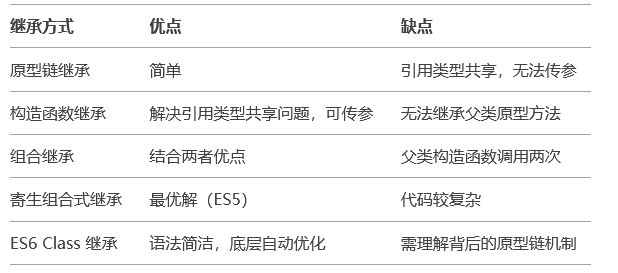JavaScript继承
原型链继承
原理:子类的原型对象指向父类的实例,通过原型链向上查找属性和方法。
缺点:所有子类实例共享父类的引用类型属性,且无法向父类构造函数传参。
js
function Parent(name){
this.name=name;
this.colors=["red","blue"];
}
Parent.prototype.sayName=function(){
console.log(this.name);
}
function Child() {}
Child.prototype = new Parent("Parent"); // 核心:子类原型指向父类实例
// 测试
const child1 = new Child();
child1.colors.push("green");
const child2 = new Child();
console.log(child2.colors); // ["red", "blue", "green"](共享问题)构造函数继承
原理:在子类构造函数中调用父类构造函数(通过call或apply),复制父类实例属性到子类。
缺点:无法继承父类原型上的方法
js
function Parent(name) {
this.name = name;
this.colors = ["red", "blue"];
}
Parent.prototype.sayName = function () {
console.log(this.name);
};
function Child(name) {
Parent.call(this, name); // 核心:调用父类构造函数
}
// 测试
const child1 = new Child("Child1");
child1.colors.push("green");
const child2 = new Child("Child2");
console.log(child2.colors); // ["red", "blue"](不共享)
child1.sayName(); // 报错:无法访问父类原型方法组合继承
原理:结合原型链继承和构造函数继承,既继承父类原型方法,又避免引用类型共享问题
问题:父类构造函数被调用两次(Parent.call和new Parent()),效率较低
js
function Parent(name) {
this.name = name;
this.colors = ["red", "blue"];
}
Parent.prototype.sayName = function () {
console.log(this.name);
};
function Child(name) {
Parent.call(this, name); // 第1次调用父类构造函数(继承属性)
}
Child.prototype = new Parent(); // 第2次调用父类构造函数(继承方法)
Child.prototype.constructor = Child; // 修正构造函数指向
// 测试
const child1 = new Child("Child1");
child1.colors.push("green");
const child2 = new Child("Child2");
console.log(child2.colors); // ["red", "blue"](不共享)
child2.sayName(); // "Child2"(可访问原型方法)原型式继承
原理:基于已有对象创建新对象(类似Object.create())
适用场景:简单对象继承,无需构造函数
缺点:与原型链继承类似,存在引用类型共享问题
js
function createObject(obj) {
function F() {}
F.prototype = obj;
return new F();
}
const parent = { name: "Parent", colors: ["red", "blue"] };
const child1 = createObject(parent);
child1.colors.push("green");
const child2 = createObject(parent);
console.log(child2.colors); // ["red", "blue", "green"](共享问题)寄生式继承
原理:在原型式继承上增强对象,添加新方法。
缺点:与原型式继承相同,存在共享问题。
js
function createEnhancedObject(obj) {
const clone = Object.create(obj);
clone.sayName = function () {
console.log(this.name);
};
return clone;
}
const parent = { name: "Parent", colors: ["red", "blue"] };
const child = createEnhancedObject(parent);
child.sayName(); // "Parent"寄生组合式继承
原理:通过Object.create()继承父类原型,避免调用两次父类构造函数
最佳实践:ES6之前最理想的继承方式
js
function inheritPrototype(child, parent) {
const prototype = Object.create(parent.prototype); // 创建父类原型的副本
prototype.constructor = child; // 修正构造函数指向
child.prototype = prototype; // 赋值给子类原型
}
function Parent(name) {
this.name = name;
this.colors = ["red", "blue"];
}
Parent.prototype.sayName = function () {
console.log(this.name);
};
function Child(name) {
Parent.call(this, name); // 继承属性
}
inheritPrototype(Child, Parent); // 继承方法
// 测试
const child1 = new Child("Child1");
child1.colors.push("green");
const child2 = new Child("Child2");
console.log(child2.colors); // ["red", "blue"](不共享)
child2.sayName(); // "Child2"ES6的Class继承
原理:通过class和extends关键字实现语法糖,底层仍是原型链继承
最佳实践:现代JavaScript推荐方式
js
class Parent {
constructor(name) {
this.name = name;
this.colors = ["red", "blue"];
}
sayName() {
console.log(this.name);
}
}
class Child extends Parent {
constructor(name) {
super(name); // 调用父类构造函数(必须在使用this之前)
}
}
// 测试
const child1 = new Child("Child1");
child1.colors.push("green");
const child2 = new Child("Child2");
console.log(child2.colors); // ["red", "blue"](不共享)
child2.sayName(); // "Child2"总结

